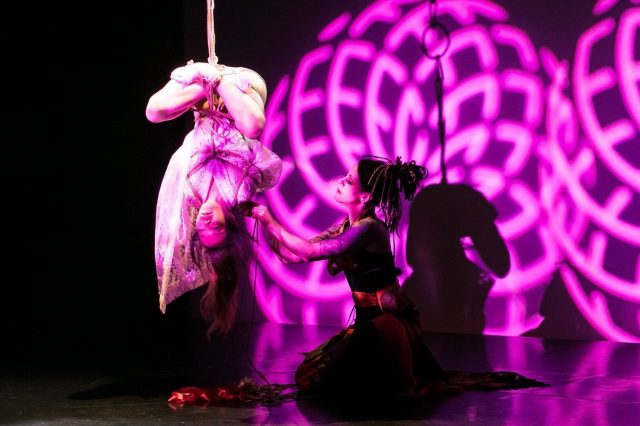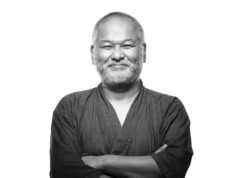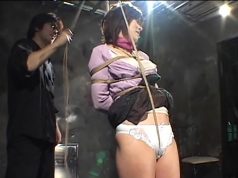Prior to arriving in Japan, Milla Reika had never heard of Kinbaku. It was not until well over a year into her stay that she would begin to learn about the hidden world of Japan’s SM culture and its connection to rope.
What brought you to Japan? Was it to learn Kinbaku?
It was nothing related to Kinbaku at all. It was just pure curiosity. I’d been back packing around the world for about three years prior, and was looking for somewhere to settle down for a year or two and just experience the culture and see what it was all about. That was during the time when I discovered Kinbaku and started on a completely different journey than what I went there for.
I understand that you began performing on stage very quickly.
It was within four months. It was a ridiculously short amount of time to obviously go on stage. I was sort of pushed there because it was the annual event of the bar where I was working.
Takamine Ren had a little bit of the ‘throw you in the deep end and let you swim’ style of teaching. Not in a harsh or mean way or an unsafe way, but more in a way to really challenge me to go further and deeper.
Did you feel pressure to succeed?
Yes, definitely. I really look at it now as a valuable learning lesson. At the time I was petrified of going on stage. I was petrified of making mistakes, especially with such little experience at the time. But I had so many experienced people around me supporting me, and obviously If anything did go wrong on a safety level, they were there to fix it up and ensure that nothing ever happened. The fact that they encouraged me and really challenged me in such a way was a blessing in disguise at the time. When you are pushed to the limit like that, you start acting more with your natural responses as well because you’ve completely gone over your capacity. In that sense it really helped me to find myself in Kinbaku a lot faster. It was an interesting way of learning and an interesting experience from the get go.
When did you start doing Kinbaku? In 2009 or 2010?
At the end of 2010. I arrived in Japan in 2009. And then took about a year and a half. At that time there were not many resources or information available in English. So after about a year and a half, when I actually learned to speak enough Japanese to negotiate the scene, that I started.
Working at the bar, did you learn Kinbaku from Mistress Takimine Ren and ShishiWaka-San?
Takimine Ren was a mentor, not so much in Kinbaku, but in the SM world. Not just how to negotiate scenes, but how to also negotiate the culture and to work in the industry as a professional. She was an overall mentor and was very well connected. BDSM and Kinbaku here are the same thing; they exist in the same world. Takimine Ren introduced me to ShishiWaka-San who taught me more about rope technique and Kinbaku. She taught me the basics in rope and has been a mentor for me throughout.
How much did you practice when you started?
When I first started, I was doing it every day. Especially when they told me I’d be doing a show. If I didn’t have someone to tie, I would be sitting at home and tying my legs or doing image training going over it in my head while I was sitting on the train. I did really just throw myself straight in there. That was the only reason, along with the support I had around me, that I was able to go on stage within such a short amount of time.
There are elements of Kinbaku that are inherently risky. Were you aware of the risks and the need for safety?
There are many aspects of safety. One is obviously the physical aspect such as potential nerve injuries or dropping someone. The other is more on the mental level. Trust. Your partner is completely surrendering their body to you and giving you complete control. Damaging that trust or breaking that trust can cause very deep injuries in that person. These injuries are not visible.
How did you learn about tying safely?
It was not sit-down instruction. Japan’s style of education is a lot of learn by watching and learn by making mistakes. Allowing you to make mistakes within a controlled environment where those mistakes are not going to be detrimental. When I was in the bar doing something, they’d let it go to the point where I’d make a mistake but not the point where it’d turn into an actual injury. It’s an interesting style of teaching as it’s really not direct teaching. It’s not “this is how it’s done, this is how it is.” It’s very ambiguous in many ways. In Japanese teaching, they won’t tell you the answer by giving it to you on a silver plate so to speak. And sometimes allowing you to make mistakes is how you come to that realization. Understanding a concept here in your head at a logical level and really understanding it deeply in your heart, are two very different things. I think you do gain a deeper understanding of it at the heart level with those direct intense experiences.
You wrote in your blog that you have four key principles for Kinbaku. Control, Composure, Intent, and Passion.
I wrote it more for myself based on many conversations and things that I’ve seen throughout my training here in Japan. It’s an understanding that I’ve come to on my own. It’s not original.
Control and Composure is the idea of being centered and controlled. Always positioning my body in the strongest position. For example, if you are sitting down with your legs crossed while you are tying someone that is standing up, if they fell, there is absolutely no way that you’re going to be able to catch them or secure them. Instead, kneel and have your shoulders and body positioned in the strongest way to catch them if they fall. The way you position yourself can really give the person you are tying a sense of firmness or dominance without necessarily being rough. I never push the person around or off balance. I’m strong and assertive with them but also tender. That brings about feelings of security in that person. They feel safe to actually let go and can entrust themselves to the person tying them.
Is that when Intent comes into play?
Exactly. I think the Intent is a strong and very important part. When you think of intent, there can be many intentions or very few; to induce a sense of humiliation or inflict pain or constraint. Whether these exist or not, the main thing is that you are intently focused on your partner. Everything is focused towards that person. You are the one that is taking control and dominating them. The fact that I am restraining them and taking away their ability to control or look after themselves, means I have to be in complete control. If I didn’t, it would be irresponsible. If I want them to be able to fully surrender themselves to me, then I have to make them feel safe and secure with me.
And Passion?
For me, it’s still an erotic experience. It’s a sexual or intimate experience. When I say sexual, maybe my definition of sexual is really different from others. It’s quite broad. There is a certain arousal or heightening of senses between two people that is very exciting for me. Adding certain elements that create pleasure for that person is a key element. I rarely use my hands to do anything very direct such as touching nipples, clitoris, anything like that. It’s achieved all through rope, through pressure and putting a person in a certain mental place. It is sexual for me but not in the sense that I want to have physical penetrative sex with that person. It’s something that occurs in the mind, and is arousing and heightening different areas than the standard physical sex that we know. I hesitate to say that word ‘sexual’ because a lot of people think of it one dimensionally and what I say gets misconstrued.
Some people that are new to Kinbaku rush to do suspensions. I’ve learned that it’s best to have a solid foundation in floor work first.
I think that’s a good thing. As I said, I jumped straight into doing suspension shows after four months of learning. I went into show rope and developed speed, dynamics, and I have really strong reflexes in the sense that I can quickly and fluidly make necessary changes if anything goes wrong. But in the last two years, I’ve taken a step back and refocused on looking at finer details. I went back to the chest ties and broke it all down. Each rope has to have a function. What is each rope doing? Is it adding to the structure of the tie? Or, is it adding something to the pleasure or to the experience of my partner? If the answer is no to either of them, then it’s pointless. I’ve done that and am going back to the basics and moving forward in a different direction.
It’s the concept of Mudaganai. There is no wastage.
Doing some pretty patterns on the back is not giving anything to my partner. It’s just doing it to stroke your own ego. Anything that is self-gratifying or has no function is just what we call ‘Top masturbation.’ If it has no function apart from looking pretty, it’s just pointless. I’ve always had that sort of thinking. When I tie privately, I don’t suspend a lot. Eighty percent of the time it’s floor work. Rather than rushing to suspend, really understanding everything on the floor first, then moving into half-suspensions is so much more enjoyable. Suspension is stressful in the beginning. Super stressful. So why make yourself stressed out and then have your partner be stressed out and have a scene that is not enjoyable? Take your time. Move into it as a natural progression.
You did a show blindfolded. Tell me about that.
Tying blindfolded I think is very powerful. In this instance, I was blindfolded while I tied and suspended my partner who was also blindfolded herself. I was playing the role of Shunkin, a blind lady from a wealthy family, from a Japanese tale written by Tanizaki Junichiro. Due to obvious risks, I removed my blindfold when it came to transitioning. However, I have done the same show in other instances where I keep the blindfold on throughout the entire show/session. Showmanship aside, it was an extremely powerful experience for me. On the stage you have the added layer of intensity; there’s an audience and there’s pressure to perform. Being blindfolded meant my senses were a lot more acute and focused in on my partner; any slight movement, the goosebumps appearing on her skin, the sound of her breathing. The fact that I could focus on this, allowed me to become more intently aware of the scene and of my partner. It was a very powerful experience for me. I’ve actually taken that and tried it in a private setting as well. You let go and when one sense is taken away, the others become heightened. If you have a chance, play around with that on the floor and do it where you can’t injure the person. I recommend doing so.
What is in store for you for the rest of 2019 and your plans for 2020?
For 2019, actually I’ve been doing shows very frequently over the last couple of months, so I’m going to take a step back there. Focusing a little bit more on my own rope and trying to progress more. Trying to pull that together and deepen my understanding. 2019 will be more preparatory. I’m wanting to put together another bigger performance piece which will probably take me about six months to create. I’ll probably start working on that soon. And then hopefully next year I want to travel a little bit, maybe travel through Europe, maybe the States. I’m not sure. Perhaps to teach or do some performances. I’ve sort of stayed within Japan and haven’t really wanted to jump on the bandwagon of traveling around and doing workshops because it just seems like when you look on the internet, that every person who has been doing rope for more than two years is now doing workshops or running around the world. And I mean that’s fine, there are some great people out there and it’s great that the content is being circulated a lot, but I do not want to jump into that ‘circus’ just yet.
There are quite a few people teaching different styles of Kinbaku.
There are people doing other sorts of styles. That’s their style and I’m not saying it’s bad.
I don’t judge. I’ve got my principles about what Kinbaku is and what it means to me. But it is free. It might not be what I would do, but I’m not them. I guess I do judge the “Look at me, I’m a rock star” people that are not even looking at their partner and the intent is not anywhere close to their partner. It’s all on themselves. Outside of that, there is freedom and it’s about the journey and the experiences between two people.
Do you teach your style?
Yeah, I have a salon that I run. I have a weekly rope night. It’s more informal; not a sit-down workshop type night. Some people come to get tied by me and get tied by other people. Some people come to learn. When people come to learn I give them advice and teach as much as I can depending on their level. It’s a ‘free’ space where people can come and be themselves; whether they want to learn, to experience or just watch and take it in. I do offer private one-on-one lessons when people approach. I haven’t really pushed myself or tried to promote myself as an instructor. I’ve been imparted a lot of valuable knowledge and I love to share that with other people. I also realize that I’ve only been doing this for nine years. I think to become a full-fledged teacher, I’d have to be doing it at this intensity for probably twenty years to really be able to teach well. Maybe that’s just the Japanese thinking that has been ingrained in me.
Your salon is in Osaka. When is it held?
At the moment it’s run weekly. Every Tuesday. But it does change depending on my schedule. I do put the schedule on my website. But it’s best if people contact me directly so I can give them the most updated information. I also run a regular Saturday night event and have alcohol available for people that just want to relax with a drink and watch. Being a Saturday night, you do get a bigger turnout and it’s more like a play party. I will sometimes put on a show or have guest performers. Sending me an email is the fastest way to get information and an answer back from me.
Do you enjoy performing more or teaching more?
I enjoy tying more. When it comes to the rope, performance and private rope are very different for me. As you can imagine, you can’t do private rope on a stage. You can do something similar, but it’s never going to be the same because you have an audience with expectations. For me, tying in private or even in my salon where I don’t have to worry about anything else except me and my partner, that is the most exciting. Performance for me has that exhibitionist element that allows me to explore that exhibitionist side of myself and also the creative and artistic side of myself. It is entertainment. It is a story. It has costumes and everything else going on around it. That’s very exciting and intense. I think it’s also a platform of expression as an artist, showing this relationship between me and my partner; the intricacies, the complexities and dynamics of these relationships.
Useful Links
The Descent of Inanna video performance: https://vimeo.com/327875231
To order your copy of The Descent of Inanna, Milla Reika’s first photo-book illustrated with stunning photographs of her stage performance: https://milla-feline.stores.jp/
Milla Reika’s website: https://www.reika-kinbaku.net
Milla Reika’s Instagram: https://www.instagram.com/milla.reika/
The shipping for the book is free.







